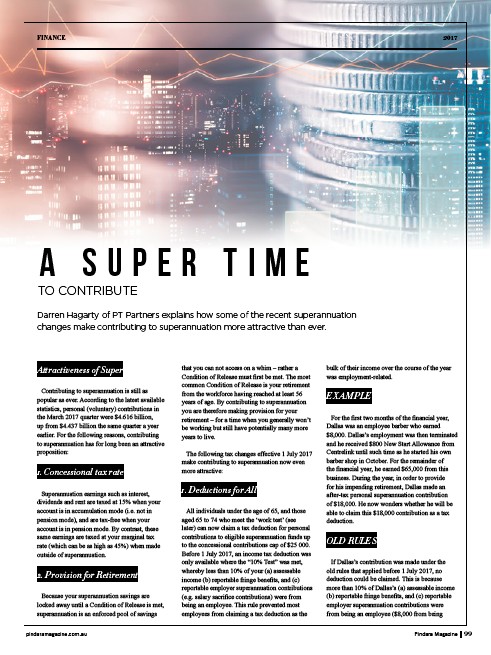
FINANCE 2017
A S u p e r T i m e
Darren Hagarty of PT Partners explains how some of the recent superannuation
changes make contributing to superannuation more attractive than ever.
Attractiveness of Super
Contributing to superannuation is still as
popular as ever. According to the latest available
statistics, personal (voluntary) contributions in
the March 2017 quarter were $4.616 billion,
up from $4.437 billion the same quarter a year
earlier. For the following reasons, contributing
to superannuation has for long been an attractive
proposition:
1. Concessional tax rate
Superannuation earnings such as interest,
dividends and rent are taxed at 15% when your
account is in accumulation mode (i.e. not in
pension mode), and are tax-free when your
account is in pension mode. By contrast, these
same earnings are taxed at your marginal tax
rate (which can be as high as 45%) when made
outside of superannuation.
2. Provision for Retirement
Because your superannuation savings are
locked away until a Condition of Release is met,
superannuation is an enforced pool of savings
that you can not access on a whim – rather a
Condition of Release must first be met. The most
common Condition of Release is your retirement
from the workforce having reached at least 56
years of age. By contributing to superannuation
you are therefore making provision for your
retirement – for a time when you generally won’t
be working but still have potentially many more
years to live.
The following tax changes effective 1 July 2017
make contributing to superannuation now even
more attractive:
1. Deductions for All
All individuals under the age of 65, and those
aged 65 to 74 who meet the ‘work test’ (see
later) can now claim a tax deduction for personal
contributions to eligible superannuation funds up
to the concessional contributions cap of $25 000.
Before 1 July 2017, an income tax deduction was
only available where the “10% Test” was met,
whereby less than 10% of your (a) assessable
income (b) reportable fringe benefits, and (c)
reportable employer superannuation contributions
(e.g. salary sacrifice contributions) were from
being an employee. This rule prevented most
employees from claiming a tax deduction as the
bulk of their income over the course of the year
was employment-related.
EXAMPLE
For the first two months of the financial year,
Dallas was an employee barber who earned
$8,000. Dallas’s employment was then terminated
and he received $800 New Start Allowance from
Centrelink until such time as he started his own
barber shop in October. For the remainder of
the financial year, he earned $65,000 from this
business. During the year, in order to provide
for his impending retirement, Dallas made an
after-tax personal superannuation contribution
of $18,000. He now wonders whether he will be
able to claim this $18,000 contribution as a tax
deduction.
OLD RULES
If Dallas’s contribution was made under the
old rules that applied before 1 July 2017, no
deduction could be claimed. This is because
more than 10% of Dallas’s (a) assessable income
(b) reportable fringe benefits, and (c) reportable
employer superannuation contributions were
from being an employee ($8,000 from being
TO CONTRIBUTE
pindaramagazine.com.au Pindara Magazine 99